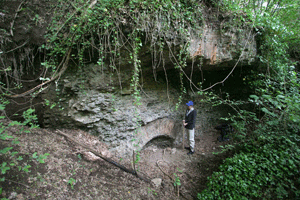Searching for the source of one of the city’s greatest engineering achievements

Archaeologist Katherine Rinne stands beside a large ancient Roman springhouse that may belong to the lost “Carestia” spring, one of the possible sources of the Aqua Traiana.
(Courtesy Rabun Taylor)
Few monuments that survive from antiquity better represent Roman pragmatism, ingenuity, and the desire to impress than the aqueducts built to fulfill the Romans’ seemingly unslakable need for water. Around the turn of the second century A.D., the emperor Trajan began construction on a new aqueduct for the city of Rome. At the time, demands on the city’s water supply were enormous. In addition to satisfying the utilitarian needs of Rome’s one million inhabitants, as well as that of wealthy residents in their rural and suburban villas, water fed impressive public baths and monumental fountains throughout the city. Although the system was already sufficient, the desire to build aqueducts was often more a matter of ideology than absolute need.
Whether responding to genuine necessity or not, a new aqueduct itself was a statement of a city’s power, grandeur, and influence in an age when such things mattered greatly. Its creation also glorified its sponsor. Trajan—provoked, in part, by the unfinished projects of his grandiose predecessor, Domitian—seized the opportunity to build his own monumental legacy in the capital: the Aqua Traiana (“Aqueduct of Trajan” in Latin).
No comments:
Post a Comment
Note: Only a member of this blog may post a comment.